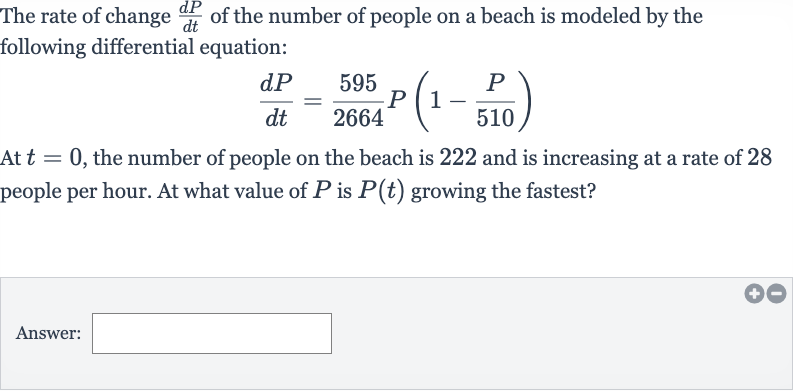AI tutor
Welcome to Bytelearn!
Let’s check out your problem:

The rate of change of the number of people on a beach is modeled by the following differential equation:At , the number of people on the beach is and is increasing at a rate of people per hour. At what value of is growing the fastest?Answer:
Full solution
Q. The rate of change of the number of people on a beach is modeled by the following differential equation:At , the number of people on the beach is and is increasing at a rate of people per hour. At what value of is growing the fastest?Answer:
- Given Differential Equation: The given differential equation is:To find the value of where is growing the fastest, we need to find the maximum point of the rate of change function . This occurs when the derivative of with respect to is equal to zero.
- Derivative Setup: Let's set up the derivative of with respect to :We apply the product rule and the chain rule to take the derivative.
- Derivative Calculation: The derivative is:Simplify the expression.
- Simplify Expression: After simplifying, we get:Now, we set this derivative equal to zero to find the critical points.
- Find Critical Points: Setting the derivative equal to zero gives us: rac{595}{2664} - rac{2 \times 595 \times P}{2664 \times 510} = 0Solve for .
- Solve for P: Multiplying through by to clear the denominators, we get:
- Isolate P: Now, we solve for P:Divide both sides by to isolate P.
- Calculate Value of P: After dividing, we find:P = The terms cancel out.
- Calculate Value of P: After dividing, we find:P = The terms cancel out.We are left with:P =
- Calculate Value of P: After dividing, we find:P = The terms cancel out.We are left with:P = Finally, we calculate the value of P:P = This is the value of P where is growing the fastest.
More problems from Interpreting Linear Expressions
QuestionGet tutor help
